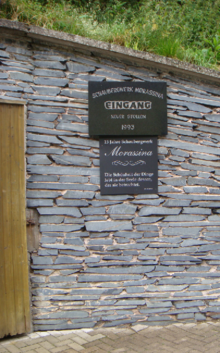Morassina
The Morassina is a former Thuringian vitriol - mine in Schmiedefeld .
Today there is a show mine with many stalactites of impressive color and variety of shapes, which even entered the Guinness Book of Records in 1996 due to its uniqueness .
Formation of the stalactites
The speed of growth of the stalactites is probably a thousand times that of the stalactite growth in the carbonate karst. The reason for this is the material of the stalactites, the relatively soft substance diadochite or mountain butter, an iron (III) -hydroxy-phosphate-sulfate-hydrate.
The mine is located in Silurian alum and silica schist . The dissolution process is linked to oxidative processes, some of which are induced by microbacteria, i.e. the oxidation with oxygen from the groundwater first leads to the formation of water-soluble substances, which are then transported away. Various minerals are precipitated in the pit according to the hydrochemical conditions. Essentially, there are sulfides , oxides , carbonates , sulfates , phosphates , vanadates , arsenates and silicates . Since these are very different substances with different colors, the stalactites have an unusual color.
history
The pit in the "sulfur hole" was first mentioned in connection with the mining of alum , iron and copper vitriol as well as sulfur and earthenware in 1683. 1717 was the first change of ownership. The merchant Johann Leonard Morassi took over the mine and named it Morassina. In 1750 the mine was sold to the Frege department store and trading company in Leipzig . Because of their possessions, the Freges were compared with the Fuggers in Augsburg and the Rothschilds in Frankfurt am Main . Frege developed his mines into market leaders in the Thuringian and Franconian regions . After alum and vitriol products could be produced more cheaply by chemical means around 1850 , the Fregesch mines quickly came to a standstill. In 1863 the Vitriolwerk Morassina delivered the last products to customers.
The entrances to the cavity system like the entire mine were forgotten. In 1951, when miners from SDAG Wismut digged up the entrances to the mine in search of uranium , they did not find any fissile material, but stalactite and sinter formations that were far and wide and were classified as particularly noteworthy even then. Because of the proximity to the inner-German border at the time , the GDR authorities prevented part of the cavities from being converted into a show mine. It was not until 1989 that the Suhl District Council , Geology Department, gave the go-ahead. In 1993 the Morassina show mine was opened. Today, together with its underground sanatorium, the "Sankt-Barbara" - Heilstollen , and its mining museum, it is considered a conglomerate of education, research, relaxation and recreation.
In the past it was personalities such as Alexander von Humboldt , August Breithaupt or the editor of the first conversation lexicon, Joseph Meyer from Gotha , who made the Schmiedefeld mining region famous, today it is the scientists Manfred Wolf , Dieter Wolf, G. Walter and Bernd Ullrich and Reinhard Gaupp , who made new scientific discoveries in relation to the Morassina mine.
The Sankt-Barbara-Stollen is used as a healing gallery for speleotherapy . The Morassina is a member of the German Healing Gallery Association .
See also
Web links
Coordinates: 50 ° 32 '4.6 " N , 11 ° 13' 29.9" E



